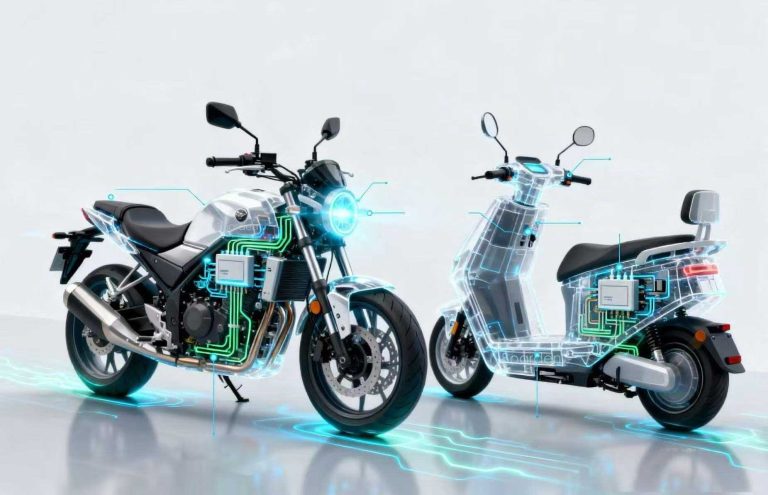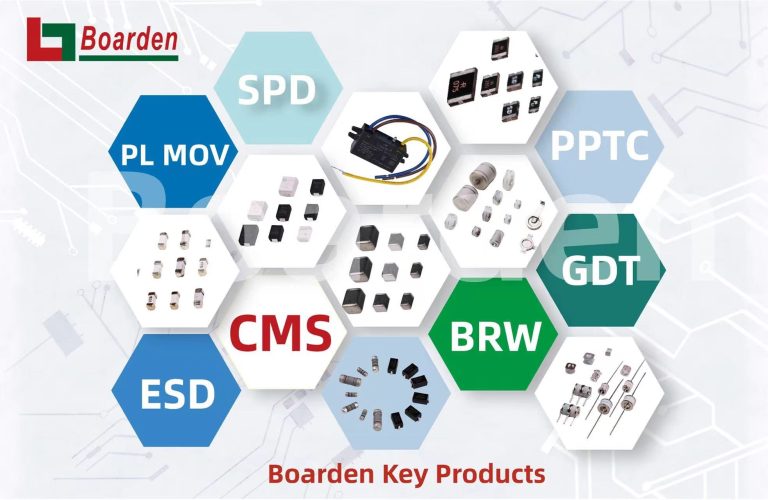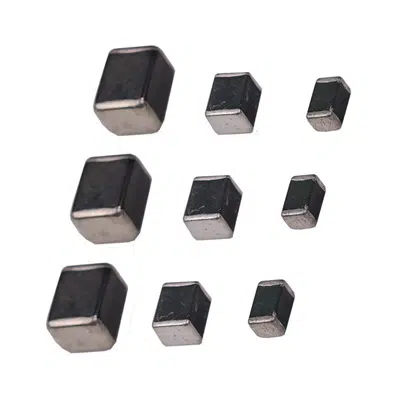As vehicles and motorcycles become increasingly electronic and intelligent, the number of electronic modules—from lighting and power control to communication and instrument systems—has grown rapidly. This growth brings more complex electrical disturbances and surge events. Surge suppression, ESD protection, and overvoltage prevention have become key to ensuring system stability and reliability.
Main Circuit Protection Applications
Lighting Systems (Headlight / HID / LED)
Lighting systems are among the most surge-sensitive areas in vehicles.
HID and LED driver modules can generate high transient surges at startup, which may damage driver ICs or MOSFETs if not properly protected.
Multilayer Varistors (MLV) and TVS diodes are commonly used for fast clamping and energy absorption at the input stage.
Motor Driver Systems (Window / Seat / Fan Motor)
During start, stop, or reversal, motors generate reverse inductive voltages and current spikes at the power terminals.
A combination of SMD MOVs, TVS diodes, and PPTC resettable fuses provides effective suppression—absorbing reverse energy while preventing overcurrent stress on the control circuit.
This design is widely applied in power windows, seat adjusters, cooling fans, and motorcycle motor control modules.
Engine Control Unit (ECU)
As the vehicle’s central control module, the ECU must withstand transient disturbances defined by ISO 7637 and ISO 16750 standards.
Automotive-grade MOVs and TVS diodes are often used at the power input and signal ports to suppress Load Dump and surge events, ensuring safe operation of the control ICs.
Driver and Display Modules (Cluster / Display / Control Board)
Display and lighting control boards integrate MCUs, display chips, and communication interfaces that are highly sensitive to ESD and surge disturbances.
ESD diodes or low-capacitance TVS diodes can be added at signal inputs, and MLVs on power lines to achieve layered protection.
Communication Interfaces (CAN / LIN / RS485 / UART)
Communication buses such as CAN, LIN, and RS485 are vital to modern automotive and motorcycle electronics.These interfaces are prone to ESD damage during manufacturing or maintenance.
Adding low-capacitance ESD diodes or transient suppression diodes across differential lines greatly enhances noise immunity and signal integrity.
Power Input and DC-DC Modules
The vehicle’s power system can generate strong surge voltages during engine start/stop or Load Dump conditions.
A three-level protection scheme combining MOV + TVS + PPTC is recommended:
MOVs absorb energy peaks, TVS diodes clamp voltage spikes, and PPTCs provide long-term overcurrent protection.
This structure is widely used in power supply and ignition control circuits.

Differences Between Motorcycle and Automotive Electronics
| Comparison | Motorcycle Electronics | Automotive Electronics |
|---|---|---|
| Voltage | 12 V with high fluctuation and frequent surges | 12 V or 24 V with more complex management |
| Environment | High temperature, humidity, vibration, limited space | More stable structure, modular design |
| Cost Sensitivity | Highly cost-sensitive, prefers compact SMD parts | Focus on reliability and automotive standards |
| Typical Applications | LED lighting, ignition modules, dashboard | ECU, motor control, power input, communication |
Motorcycle systems prioritize compactness and cost efficiency, often using high-density SMD protection devices.
Automotive systems emphasize long-term reliability and standardized qualification such as AEC-Q200.
Technical Highlights
- Multilayer Varistors (MLV): Fast response, compact size—ideal for lighting and instrumentation
- SMD MOV + TVS combination: Balanced energy absorption and voltage clamping
- PPTC and ESD diodes: Dual protection for overcurrent and electrostatic discharge
- AEC-Q200 compliance: Ensures automotive-grade reliability
Conclusion
Circuit protection is essential to the reliable operation of automotive and motorcycle electronics.
Proper component selection and layout design effectively prevent damage caused by surge, ESD, and overvoltage events.
Boarden’s expertise originates from HID headlamp surge protection and has expanded to motor control, communication interfaces, and power modules.
Today, Boarden provides comprehensive automotive-grade circuit protection solutions that help OEM and EMS customers achieve long-term reliability and compliance.
For detailed product information or sample requests, please contact Boarden
Meta 信息(中英对照)
Meta Title(建议):
汽车与摩托车电路保护 | 车规级浪涌与ESD防护设计指南
Meta Description(中英文对照):
中文:
了解汽车与摩托车电子系统中的电路保护设计思路,包括灯具驱动、电机控制、ECU、电源与通信接口的浪涌、ESD与过压防护方案。
Boarden 专注车规级压敏电阻(MOV/MLV)、TVS、PPTC、ESD元件应用,为整车电子提供高可靠性防护解决方案。
English (shorter):
Explore circuit protection in automotive and motorcycle electronics—covering surge, ESD, and overvoltage design for lighting, ECU, and motor control systems.
🔑
Keywords(关键词建议)
- automotive circuit protection
- motorcycle electronics surge protection
- MLV varistor automotive
- SMD MOV TVS diode
- Load Dump protection
- automotive ESD protection
- PPTC resettable fuse
- AEC-Q200
🖼
图片生成提示词(用于网站插图 / 封面)
英文提示词:
“automotive circuit protection concept, car PCB board with surge and ESD icons, motorcycle ECU illustration, modern electronics protection design, blue technical background, high-tech clean style”
中文解释:
一张汽车与摩托车电子防护的概念图,可包含线路板、电路保护图标(如闪电、TVS、ESD符号)、车灯与电机模块示意,整体科技蓝色风格、简洁高亮。
是否希望我下一步把这篇内容生成成 WordPress 发布格式(含 <meta> 标签、H1/H2/H3 层级和图片ALT文本)?
那样可以直接复制到你网站后台使用。





